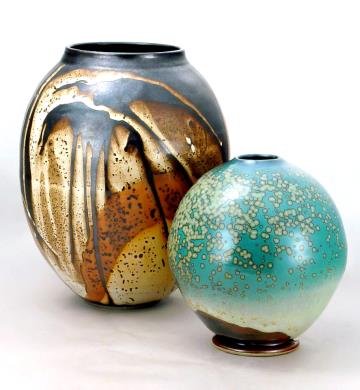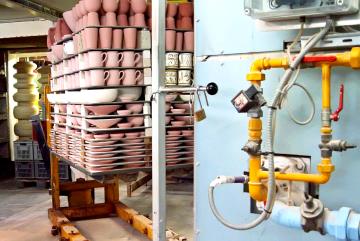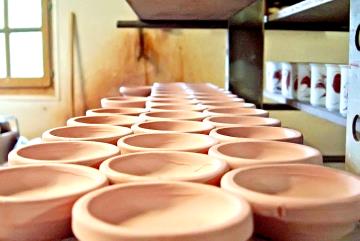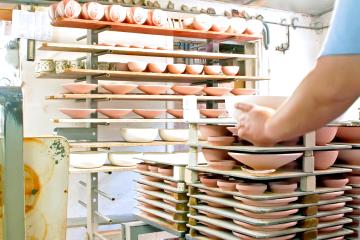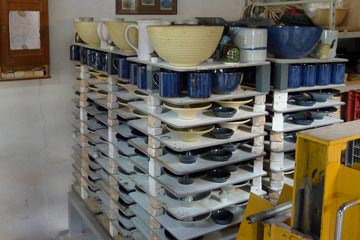The pottery and its context
The pottery workshop at Taizé is fully integrated into the life of the community. Work in the pottery is part of this broader context and explains a number of practical choices that have been made.
The ceramic adventure began in the winter of 1949, when a workshop was set up in Taizé, which gradually developed with the main focus on hand-turning and the development of stoneware glazes, using mainly plant-based ashes.
As the community grew larger, the brothers continued to cover their living costs entirely through their own work. It should be noted that most brothers also have another activity within the framework of the community’s ministry. The production is therefore done using simple processes, some of which are mechanised - such as calibration, molding and pressing - producing objects for daily use.
Two simple processes have been carried over from the first workshop: the preparation of the clay from raw materials quarried locally and the creation of the workshop’s characteristic glazes.
A short introduction
The clay composing the pots produced at Taizé is vitrified at 1280°C. This produces the pottery known as “stoneware.” Before they are glazed, the objects receive an initial firing at 950°C.
Certain objects (lamps, birds, ...) are made using a porcelain paste in a molding workshop.
Stoneware glazes are silicates formed at 1280°C by the fusion of mixtures of various minerals : feldspar, kaolin, chalk, silica, talc. They may be colored by adding pigments such as iron oxides that produce ivory, green, black and brown glazes, cobalt or copper for blue and violet, titanium for orange-yellow. The glazes sometimes include plant ash composed of the minerals the plants drew from the ground. These ashes can also be reconstituted using the same proportions of minerals, as is the case for several of our glazes.
For the first firing of our pieces, we work together with some local workshops, as an expression of solidarity with other potters: we are unable to keep up on our own with the demand.
Our main glazes
Gousseau (yellow) : the reconstitution of a glaze originally obtained using the ashes from a mixture of trees from the nearby woods known as the Forest of Gousseau.
Omnia (matt green) : a glaze made by mixing various glazes.
Blue : a glaze using a reconstitution of ash from the Bresse woodlands, enriched with cobalt oxide.
Okoumé (matt grey-blue) : the reconstitution of a glaze made using the ashes of waste from an exotic wood formerly used in a local carpentry workshop.
Temmoku (black with reddish touches) : a Japanese name for a classic iron-based glaze that originated in China over 1,000 years ago.
Bois de Bresse (brilliant white) : the reconstitution of a glaze made using the ashes of hedge trimmings from the Bresse region, not far from Taizé.
Noisette (semi-matt brown) : the reconstitution of a glaze using hazelnut shells from Spain.
Iron red (rusty brown) : an iron-based glaze containing phosphorus.
Yellow : a glaze rich in alumina, enriched with titanium oxide.
Some practical information
All the objects we produce withstand dish-washers and microwave ovens. They should not be placed in a very hot oven (above 200°C).
Because of the risk of breakages, we no longer send any packed pottery by post, with the exception of three articles.
 TAIZÉ
TAIZÉ